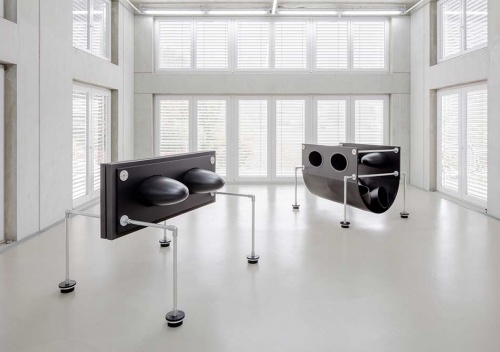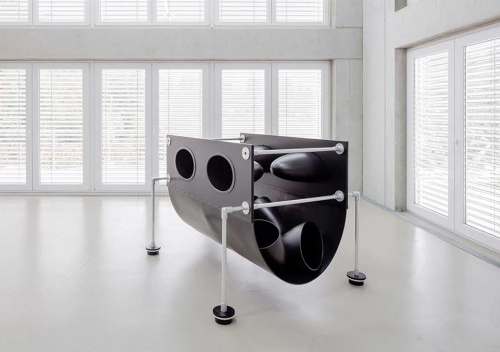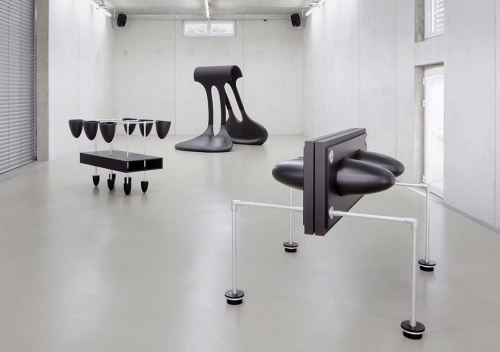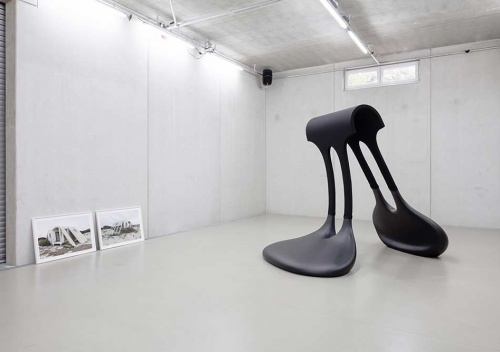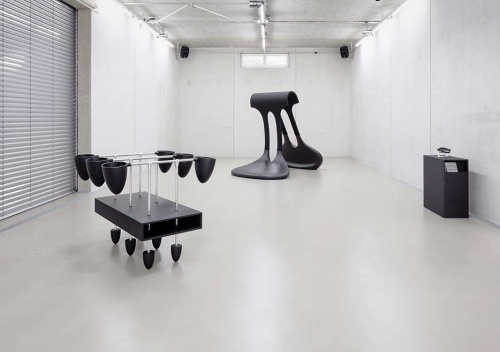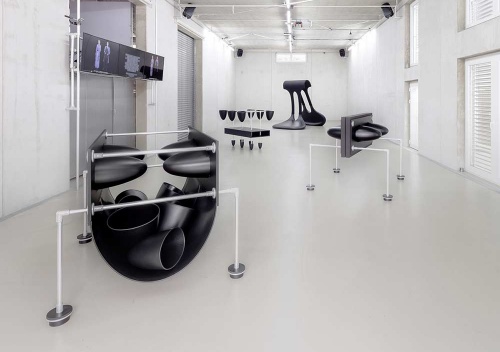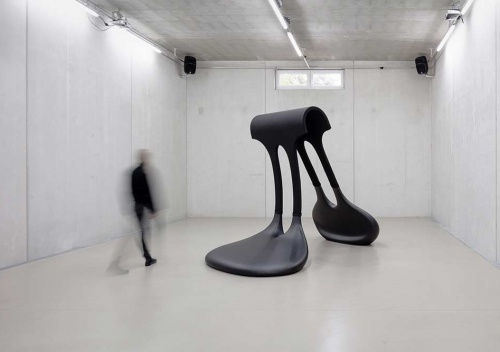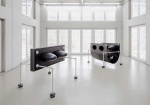 I can´t see you 2, 2019, MDF, aluminium, foamrubber, 125 x 132 x 163 cm (left);
I can´t see you 2, 2019, MDF, aluminium, foamrubber, 125 x 132 x 163 cm (left);
I can´t see you 1, 2019; MDF, Polyurethan, aluminium, rubber; 120 x 132 x 154 cm (right);
Photo: Georg Molterer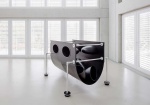 I can` t see you 1, 2019, MDF, polyurethan, aluminium, rubber; 120 x 132 x 154 cm
I can` t see you 1, 2019, MDF, polyurethan, aluminium, rubber; 120 x 132 x 154 cm
Photo: Georg Molterer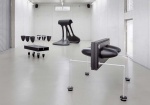 Miss Needy, Again and Again, I can´t see you 2 (fltr); TANK 203.3040.AT, 2019
Miss Needy, Again and Again, I can´t see you 2 (fltr); TANK 203.3040.AT, 2019
Photo: Georg Molterer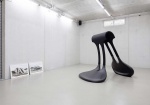 O.T. (Strand) 1+2, 2017 (left);
O.T. (Strand) 1+2, 2017 (left);
Again and Again, 2017, aluminium, PVC, foam rubber, textile, Acrystal; 240 x 190 x 285 cm (right);
Photo: Georg Molterer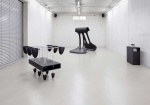 Miss Needy, Again and Again, 3D glasses (fltr), TANK 203.3040.AT, 2019
Miss Needy, Again and Again, 3D glasses (fltr), TANK 203.3040.AT, 2019
Photo: Georg Molterer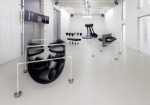 I can´t see you 1, Miss Needy, Again and Again, I cant see you 2; (fltr) TANK 203.3040.AT, 2019
I can´t see you 1, Miss Needy, Again and Again, I cant see you 2; (fltr) TANK 203.3040.AT, 2019
Photo: Georg Molterer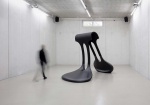 Again and Again, 2017, aluminium, PVC, foam rubber, textile, Acrystal; 240 x 190 x 285 cm
Again and Again, 2017, aluminium, PVC, foam rubber, textile, Acrystal; 240 x 190 x 285 cm
Photo: Georg Molterer
I can´t see you 1+2
, TANK 203.3040.AT, 2019
Ambivalences – Julie hayward + Ruth Schnell in the TANK 203.3040.AT
...
Julie Hayward and Ruth Schnell, the two artists who were brought together in this exhibition, have little in common on closer inspection. Their different approaches lead to two completely different views of art. Julie Hayward’s sculptures unfold an overarching presence in space, while Ruth Schnell’s media installation could not be grasped without the mediating technique of HoloLens. Despite this apparent discrepancy, the exhibition is perceived as coherent, and one wonders why. The compilation of the works of Schnell and Hayward is part of the ongoing series "Strategic Complements", which Graf+Zyx have been organising for several years at the exhibition space TANK 203.3040.AT the intention of which is precisely to evoke such discrepancies. On the one hand, these "complements" represent surprising and unusual constellations, but on the other hand, on closer inspection, they also reveal obvious connections between two artistic positions.
So why is it, I wondered, that our eye and our cognitive faculty work so hard to draw parallels between the most extreme opposites? For that is what I would call the two positions of Schnell and Hayward. Is it because we cannot deal with the misunderstood, the disparate? Does our mind tend to create order when chaos threatens, so as not to plunge us into the proverbial darkness of mental derangement?
In his book "Modernity and Ambivalence", the sociologist and philosopher Zygmunt Bauman referes to that "search for order", through the naming and classifying functions of our language, which seeks to avoid ambivalence because it creates unease. But, and this is also what Bauman’s book is about, ambivalence cannot be avoided in the final analysis, because the postulated performance of order can never be completely completed by our consciousness (nor by any other instances). In other words: we cannot create a complete non-ambivalent situation in our perception and therefore can never achieve complete clarity about it. Nevertheless, our consciousness wants to create at least smaller units of coherence in order to be able to accept (more comfortably) in this situation that this endeavour can only partially succeed. So we prefer to fail unambivalently rather than feeling uneasy about our inability to create clarity in ambivalence.
On this basis of ambivalence, it is therefore possible to record things about the works of the two artists that are contingent. For the intuitive association that led the curators Graf+Zyx to bring these artists together also corresponded to an artistic logic that we are also following. The attraction of these complements between Hayward and Schnell lies in their apparent incompatibility: here the very physical sculptures of Julie Hayward, conceived as unique objects, and there the virtual implementation of two theory-critical scientific biographies in the work of Ruth Schnell. Schnell uses high-tech applications to work with data glasses and hologram, while Hayward’s sculptures, although corporeal, also play with a distinctly technoid feel.
Positions and Space
The four sculptures by Julie Hayward play with different presences in the room. A certain complementary relationship connects the two latest works: "I can’t see you 1" and "I can’t see you 2" from 2019, both of which combine a framework of aluminium tubes with different elements: In "I can’t see you 1" a 6 mm thick rubber layer hangs like a tub between the framework and two lacquered MDF panels, and in "I can’t see you 2" a foam rubber mat held in place by the same MDF panels. Striking parts, to which the title of the works also refers, are inverted forms that "look" like eyeballs sometimes inside, sometimes outside. The two objects are complementary in the alignment of their hollow forms, which allow the extracted stem eyes to look sometimes inwards and sometimes outwards.
The largest work "Again and again" (2017) is 2.4 m high. It almost seems to stick to the ground and at the same time wants to move somehow. Seen from close up, we also see an elastic fabric that tightly wraps the four foam rubber legs. The sculpture seems to tilt, frozen in motion. It is no coincidence that such organic, amorphous associations appear: The origin of Hayward’s works - and in this she is extremely consistent - are designs that are created freely on paper and are worked on until the "form has peeled itself out of the original thought", as Hayward says with reference to Jean Starobinski. She works from these drawings to create three-dimensional concepts and to plan her manual elaboration, which is often long and complex. The appeal of these works lies in their being torn between biomorphic and futuristic appearance at the same time. They are based on the symbolic, a narrative, descriptive moment, which is also emotionally and psychologically demanding.
While "Again and again" is more connoted as a frozen biomorphism, the three other works take a slightly different direction: Not only "I can’t see you 1 / I can’t see you 2" have a machine-affinity in their arrangement, "Miss Needy" (2016) is also a composition of MDF, aluminium tubes and polyester forms coated with soft lacquer, which form similar cylindrical hollow forms as the younger contrasting pair.
The material basis from which Hayward’s sculptures are made is a world of its own: with great precision in planning and production, a fine combination of a wide variety of special designs is created, such as the laser-cut aluminium discs, the special "rubber feet", or the bookbinder’s sleeve nuts with which some parts of "I can’t see you 1 and 2" are held together. In addition to these four sculptural works Hayward shows two photographs from her series of space situations, here two photographs of an abandoned bunker in France.
Julie Hayward’s works evoke an intense parallel world drawn from a fund of the human psyche. Her oscillation between organic-biomorphic and futuristic-mechanical formal language cannot be grasped in any representational terms - but this is precisely why these objects prove to be autonomous. The artist thus represents something that would otherwise not be visible - and it is in this shift of reality from the psychic to a physical body which does not correspond to our human shell where their meaning lies.
In contrast, "CombatScience Augmented" by Ruth Schnell creates a virtual parallel world. The work, developed in 2018 as an Augmented Reality Installation, is based on a performative collage from 2008 designed for the Volkstheater Wien and was realised in a new sensory setting with data glasses and HoloLens. With this advanced technical tool, the AR data glasses without cables, we can move freely in space. Fast digital holographic miniatures and scenarios interact in a certain way with Hayward’s sculptures by wrapping themselves around them and distributing between them.
In her installation Ruth Schnell takes up the life stories of the chemist Fritz Haber (1868-1934) and his wife, Clara Immerwahr (1870-1915), who also holds a doctorate in chemistry. These serve as a foil from which various fields of events are developed, which are devoted to questions about the role of science between the ethics of research and the thinking of feasibility.
Quote from a text by Ruth Schnell: "Fritz Haber and Clara Immerwahr were a couple with opposite mindsets: Haber used his knowledge as chief architect of the German gas warfare during World War I, and the pacifist Immerwahr committed suicide after the first poison gas deployment by German troops. The alienation of the couple had begun much earlier: The ambitious chemist Clara Immerwahr, one of the first women in Germany to receive a doctorate, was pushed out of the laboratory and into the role of wife and worker.
Through data glasses we see a kind of intimate play in which an actor and an actress speak text fragments and monologues from the biographies of the scientists*. The installation has been updated with text objects and autonomous sound clouds that address the implications, or rather the social consequences of artificial intelligence and algorithms - today’s technological applications.
In this work, Ruth Schnell combines the latest technology with an explicit call for responsibility and competence to act. Ethical awareness juxtaposes her with the older technology as well as with the most recent, present-day technology. In doing so, she warns against fantasies of feasibility that rely solely on the role of scientific concepts without considering their effects on humans. Schnell’s works in their different mediality have repeatedly dealt with the resources and possibilities of given, existing technologies, but also with the "transformation processes of image, body and space representations caused by technology" (Schnell). Her work deals with a phenomenology of visual perception in close connection with immersive spatial settings, through which "reality" can be understood and configured in a new way. And so in this installation, in which virtual elements overlap with physically tangible ones, she extends the experiential space of digital and real presence.
In the space of TANK 203.3040.AT the different approaches of both artists interact with each other. Through the AR data glasses they connect in a new area of possibilities. Avoiding ambivalence also means allowing new relationships here.
***
I remain with my thoughts in the exhibition and return to our initial question: the observation that our consciousness apparently cannot stop constructing parallels between apparently incompatible things. That this observation is one of the basic insights of intellectual history after the Renaissance is shown by countless examples in the visual arts, where it was precisely in such amour-fou constellations that a recovery from the mental compulsion to order was seen. The attraction lay and still lies in being able to evade the strict mental corset in a surprising way and to develop an own "senseless" sense in the divergence and difference of the logics.
This, for example, was entirely in the spirit of Mannerism, in which there was also talk of a necessary disunity, a union of opposites, the "discordia concors", or conversely of a "concordia discors", the disunity of the one. It is precisely in the singularity of the respective works that we can thus associatively allow commonalities to emerge - without any claim to totality. Or - to cite another example from art history - we can speak in the sense of surrealist poetry "of the beauty of the accidental meeting of an umbrella and a sewing machine on a dissecting table".
...
Julie Hayward and Ruth Schnell, the two artists who were brought together in this exhibition, have little in common on closer inspection. Their different approaches lead to two completely different views of art. Julie Hayward’s sculptures unfold an overarching presence in space, while Ruth Schnell’s media installation could not be grasped without the mediating technique of HoloLens. Despite this apparent discrepancy, the exhibition is perceived as coherent, and one wonders why. The compilation of the works of Schnell and Hayward is part of the ongoing series "Strategic Complements", which Graf+Zyx have been organising for several years at the exhibition space TANK 203.3040.AT the intention of which is precisely to evoke such discrepancies. On the one hand, these "complements" represent surprising and unusual constellations, but on the other hand, on closer inspection, they also reveal obvious connections between two artistic positions.
So why is it, I wondered, that our eye and our cognitive faculty work so hard to draw parallels between the most extreme opposites? For that is what I would call the two positions of Schnell and Hayward. Is it because we cannot deal with the misunderstood, the disparate? Does our mind tend to create order when chaos threatens, so as not to plunge us into the proverbial darkness of mental derangement?
In his book "Modernity and Ambivalence", the sociologist and philosopher Zygmunt Bauman referes to that "search for order", through the naming and classifying functions of our language, which seeks to avoid ambivalence because it creates unease. But, and this is also what Bauman’s book is about, ambivalence cannot be avoided in the final analysis, because the postulated performance of order can never be completely completed by our consciousness (nor by any other instances). In other words: we cannot create a complete non-ambivalent situation in our perception and therefore can never achieve complete clarity about it. Nevertheless, our consciousness wants to create at least smaller units of coherence in order to be able to accept (more comfortably) in this situation that this endeavour can only partially succeed. So we prefer to fail unambivalently rather than feeling uneasy about our inability to create clarity in ambivalence.
On this basis of ambivalence, it is therefore possible to record things about the works of the two artists that are contingent. For the intuitive association that led the curators Graf+Zyx to bring these artists together also corresponded to an artistic logic that we are also following. The attraction of these complements between Hayward and Schnell lies in their apparent incompatibility: here the very physical sculptures of Julie Hayward, conceived as unique objects, and there the virtual implementation of two theory-critical scientific biographies in the work of Ruth Schnell. Schnell uses high-tech applications to work with data glasses and hologram, while Hayward’s sculptures, although corporeal, also play with a distinctly technoid feel.
Positions and Space
The four sculptures by Julie Hayward play with different presences in the room. A certain complementary relationship connects the two latest works: "I can’t see you 1" and "I can’t see you 2" from 2019, both of which combine a framework of aluminium tubes with different elements: In "I can’t see you 1" a 6 mm thick rubber layer hangs like a tub between the framework and two lacquered MDF panels, and in "I can’t see you 2" a foam rubber mat held in place by the same MDF panels. Striking parts, to which the title of the works also refers, are inverted forms that "look" like eyeballs sometimes inside, sometimes outside. The two objects are complementary in the alignment of their hollow forms, which allow the extracted stem eyes to look sometimes inwards and sometimes outwards.
The largest work "Again and again" (2017) is 2.4 m high. It almost seems to stick to the ground and at the same time wants to move somehow. Seen from close up, we also see an elastic fabric that tightly wraps the four foam rubber legs. The sculpture seems to tilt, frozen in motion. It is no coincidence that such organic, amorphous associations appear: The origin of Hayward’s works - and in this she is extremely consistent - are designs that are created freely on paper and are worked on until the "form has peeled itself out of the original thought", as Hayward says with reference to Jean Starobinski. She works from these drawings to create three-dimensional concepts and to plan her manual elaboration, which is often long and complex. The appeal of these works lies in their being torn between biomorphic and futuristic appearance at the same time. They are based on the symbolic, a narrative, descriptive moment, which is also emotionally and psychologically demanding.
While "Again and again" is more connoted as a frozen biomorphism, the three other works take a slightly different direction: Not only "I can’t see you 1 / I can’t see you 2" have a machine-affinity in their arrangement, "Miss Needy" (2016) is also a composition of MDF, aluminium tubes and polyester forms coated with soft lacquer, which form similar cylindrical hollow forms as the younger contrasting pair.
The material basis from which Hayward’s sculptures are made is a world of its own: with great precision in planning and production, a fine combination of a wide variety of special designs is created, such as the laser-cut aluminium discs, the special "rubber feet", or the bookbinder’s sleeve nuts with which some parts of "I can’t see you 1 and 2" are held together. In addition to these four sculptural works Hayward shows two photographs from her series of space situations, here two photographs of an abandoned bunker in France.
Julie Hayward’s works evoke an intense parallel world drawn from a fund of the human psyche. Her oscillation between organic-biomorphic and futuristic-mechanical formal language cannot be grasped in any representational terms - but this is precisely why these objects prove to be autonomous. The artist thus represents something that would otherwise not be visible - and it is in this shift of reality from the psychic to a physical body which does not correspond to our human shell where their meaning lies.
In contrast, "CombatScience Augmented" by Ruth Schnell creates a virtual parallel world. The work, developed in 2018 as an Augmented Reality Installation, is based on a performative collage from 2008 designed for the Volkstheater Wien and was realised in a new sensory setting with data glasses and HoloLens. With this advanced technical tool, the AR data glasses without cables, we can move freely in space. Fast digital holographic miniatures and scenarios interact in a certain way with Hayward’s sculptures by wrapping themselves around them and distributing between them.
In her installation Ruth Schnell takes up the life stories of the chemist Fritz Haber (1868-1934) and his wife, Clara Immerwahr (1870-1915), who also holds a doctorate in chemistry. These serve as a foil from which various fields of events are developed, which are devoted to questions about the role of science between the ethics of research and the thinking of feasibility.
Quote from a text by Ruth Schnell: "Fritz Haber and Clara Immerwahr were a couple with opposite mindsets: Haber used his knowledge as chief architect of the German gas warfare during World War I, and the pacifist Immerwahr committed suicide after the first poison gas deployment by German troops. The alienation of the couple had begun much earlier: The ambitious chemist Clara Immerwahr, one of the first women in Germany to receive a doctorate, was pushed out of the laboratory and into the role of wife and worker.
Through data glasses we see a kind of intimate play in which an actor and an actress speak text fragments and monologues from the biographies of the scientists*. The installation has been updated with text objects and autonomous sound clouds that address the implications, or rather the social consequences of artificial intelligence and algorithms - today’s technological applications.
In this work, Ruth Schnell combines the latest technology with an explicit call for responsibility and competence to act. Ethical awareness juxtaposes her with the older technology as well as with the most recent, present-day technology. In doing so, she warns against fantasies of feasibility that rely solely on the role of scientific concepts without considering their effects on humans. Schnell’s works in their different mediality have repeatedly dealt with the resources and possibilities of given, existing technologies, but also with the "transformation processes of image, body and space representations caused by technology" (Schnell). Her work deals with a phenomenology of visual perception in close connection with immersive spatial settings, through which "reality" can be understood and configured in a new way. And so in this installation, in which virtual elements overlap with physically tangible ones, she extends the experiential space of digital and real presence.
In the space of TANK 203.3040.AT the different approaches of both artists interact with each other. Through the AR data glasses they connect in a new area of possibilities. Avoiding ambivalence also means allowing new relationships here.
***
I remain with my thoughts in the exhibition and return to our initial question: the observation that our consciousness apparently cannot stop constructing parallels between apparently incompatible things. That this observation is one of the basic insights of intellectual history after the Renaissance is shown by countless examples in the visual arts, where it was precisely in such amour-fou constellations that a recovery from the mental compulsion to order was seen. The attraction lay and still lies in being able to evade the strict mental corset in a surprising way and to develop an own "senseless" sense in the divergence and difference of the logics.
This, for example, was entirely in the spirit of Mannerism, in which there was also talk of a necessary disunity, a union of opposites, the "discordia concors", or conversely of a "concordia discors", the disunity of the one. It is precisely in the singularity of the respective works that we can thus associatively allow commonalities to emerge - without any claim to totality. Or - to cite another example from art history - we can speak in the sense of surrealist poetry "of the beauty of the accidental meeting of an umbrella and a sewing machine on a dissecting table".
